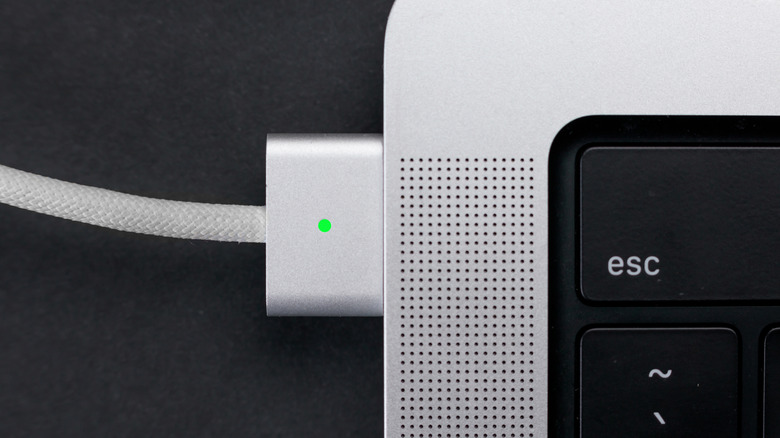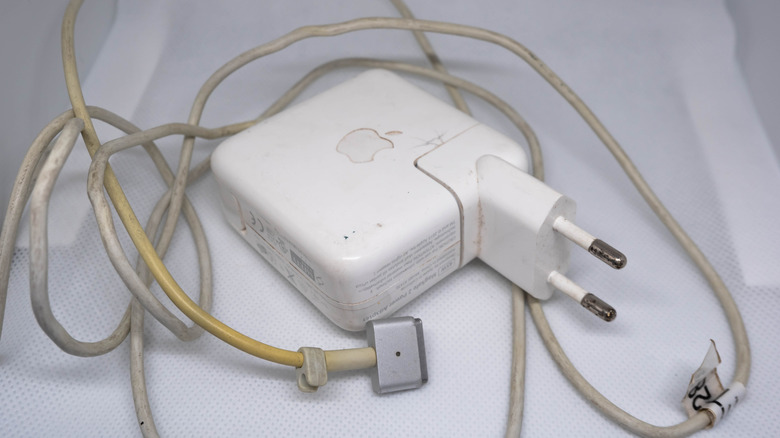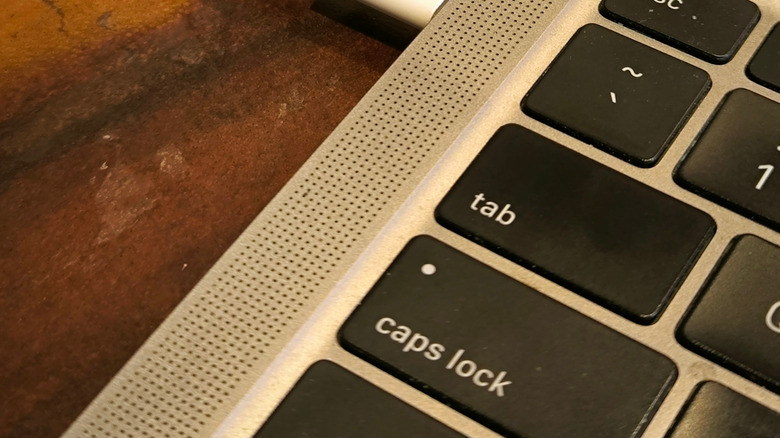Why Do Some Apple MacBook Chargers Turn Yellow? Here's What We Know
We may receive a commission on purchases made from links.
Apple has been around for decades, building its reputation over time as one of the premier names in the technology world. The brand has specialized in everything from home computers to phones since its launch, cultivating a fanbase that is ready and willing to give any and all of its innovations a try. Naturally, among these ever-evolving offerings is Apple's line of laptops, known as MacBooks, which took the tech world by storm with their 2006 introduction and have remained in the headlines with each passing iteration.
From the original models to recent takes like the 2024 release, the MacBook Air M3, MacBooks aren't too difficult to figure out. Apple makes them pretty user-friendly, mitigating that annoying period of struggling to do even the most basic of things with it. Still, there are some questions that arise now and again. Alongside common queries like whether a MacBook is a good idea for college or if one is worth the monetary investment at all, there are some more out-there ones to answer. For instance, why do some Apple MacBook chargers go from white to yellow after extended use? If you or someone you know has a yellowed MacBook charger, you should know that there are a few likely reasons for this odd change, ranging from heat, to age, to the oils from your hands.
A few factors may contribute to MacBook charger yellowing
As it turns out, the yellowing of MacBook chargers is far from uncommon. Unfortunately, Apple hasn't directly explained why this happens so often. Thus, folks online have discussed this phenomenon numerous times, conjuring up a handful of potential factors to blame. First and foremost is the frequently cited theory that this is due to a buildup of heat when charging. As a result of constant exposure to high temperatures, most forms of plastic are susceptible to discoloration over time. MacBook chargers, especially on the ends where the wires plug into the charging block and the MacBook itself, are no exception to this.
Another prevailing idea is that MacBook chargers yellow in specific areas as a result of near-constant contact with human hands. No matter how often you wash your hands, your skin secretes natural oils that can rub off onto whatever you might touch throughout the day. When you grab the end of your charger to plug it into your MacBook, you're regularly adding oils and other substances that could cause staining and, therefore, discoloration. If you want to try avoiding this, Apple recommends that you clean your charging cable with a damp cloth, wipe it up and down its length, and then dry it off with a clean, dry cloth.
Regardless of the reason behind yellowing in MacBook charging cables, the matter of whether using these cables is safe is worthy of discussion.
What to do about a yellowed MacBook charging cable
Is it safe to use yellowing MacBook cables? If you're able to clean yours and reduce or even eliminate the discoloration there's likely not a risk to keeping your charger around for a while longer. On the other hand, if heat is the issue, as evidenced by additional signs like the charger feeling warm, a burning smell, or even smoke coming from it, then it's a no-brainer that a new charger is in order — perhaps even one that ideally will last longer and be more resistant to damage.
If you're in the market for a new charging cable, the Apple USB-C woven charge cable is worth considering. While they can be more expensive than their more traditional rubber-plastic counterparts, and they are prone to getting dirty, braided cables are designed to be more sturdy and prevent breakage, as well as avoid tangling. One's mileage may vary, but they're undoubtedly a strong alternative if you're worried a regular MacBook charging cable will sustain heat damage and turn yellow shortly after you purchase it.
Electronics are great, but unfortunately, they don't last forever — especially Apple charging cables, which tend to break pretty often. If your MacBook charger doesn't just need a good clean, odds are it has taken some kind of heat damage. If this is the case, it's better to be safe than sorry, opting for a replacement instead of pushing the aging cable beyond its limits.


